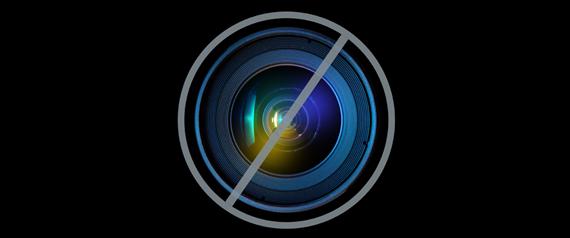Scott Snibbe is a New York-based media artist whose innovative vision has taken the art and music worlds to new depths of interactivity. From giant, digital public installations to touch-screen based art, the visual artist behind musicians like Bjork and Passion Pit is bringing together art, music and technology in groundbreaking ways.
Snibbe initially took center stage in the late 1990s when he became one the first artists to work with projector-based interactivity, a technique that involved computer-generated images screened onto walls or floors that would respond to the movement of people. But he's recently become more well known for creating some of the first interactive art applications for iOS mobile devices. His first three apps -- Gravilux, Bubble Harp, and Antograph -- came out in 2010 and quickly rose in the ranks of iTunes popularity. Combining his love for science, music, gaming and animation, the applications allowed users to explore the mysteries of chemical traits and gravitational pulls, literally available at their fingertips.
The artist's mastery of interactive animation drew the attention of Icelandic crooner Bjork, who recruited him to design the digital projections used during her on-stage performances. And in 2011, he collaborated with the singer to create the first full-length app album for her recent record, "Biophilia." The app enabled listeners of the album to interact with the music, creating visual representations of Bjork's darkly science-soaked lyrics that would change and evolve in response to the mobile device user's touch. Snibbe has since created more iOS-friendly art, worked with director James Cameron and collaborated on a new app album with the indie band, Passion Pit. We asked him some questions about his collaborations with Bjork and Passion Pit and his take on the future of the music listening experience: Scroll down for images.

HP: You're known for the visual graphics you provided for Bjork's album "Biophilia," most recently in the form of a mobile application, as well as a number of art installations that you've created in public spaces. Do you feel like you have more freedom in the three-dimensional world or is the touch-screen your new medium of choice?
SS: The touch-screen offers more freedom because there is no physical world to push against. Interactive screen-based software art was my first love, and something I was doing from age ten in 1980 on my Apple II+ up through about 2002. I went into installations in the mid-90s, and that work took over in the naughts because at the time there was more of an audience in galleries and public spaces for that kind of interactive art. And, when showing in galleries, I thought it better to engage their whole bodies, and not collapse each person to his fingertip. Once Apple's App Store opened, I freaked out, because I could go back to these screen-based interactive art I'd been making, and finally distribute it to the masses--the same way musicians and filmmakers do. What always blew my mind about software is that you are only limited by your own imagination and ability. There's no hard limit to what you can achieve with pure software, in contrast to the physical world where you need materials, equipment, permits, and so on. And now with the App Store, there's also no one you need to convince to distribute your software.

HP: We hear you're working with the band Passion Pit. Can you tell us a bit about this project?
SS: Yes, this is a new interactive music app project in conjunction with their new album "Gossamer". We started with a small project at the Webby Awards a couple months ago, doing video backdrops to their new single "Take a Walk." Then we expanded the collaboration to an app "EP" featuring two songs, including one that hasn't yet been heard, "Carried Away." Each song can be experienced in two modes - one is an interactive music video, where the sequencing of graphics, animation, and photographs by Mark Borthwick are different every time. And if you touch the screen you make your own kind of music video.
The second mode for each song is a "remixer" in which people can create their own music with Passion Pit's raw material. For "Take a Walk," people can create new melodies on top of a backing track, by creating kind of harp-string spider webs. In the remixer for "Carried Away," all the parts of the song can be turned on and off via touch tiles. Some loop, while others are simple notes. If you're skilled enough you can actually play the song through, and I'm looking forward to seeing if anyone pulls it off and posts to YouTube.
The imagery for the app is all based on a bubble-like diagram that's technically called a "Voronoi Diagram." I learned about this pattern in school and it always fascinated me because it relates to everything from the structure of cells to the gravitational influence of stars. I chose it for this app because the first song, "Take a Walk" is about the financial bubble, and a kind of hangover healing process coming out of it, so I thought this fragmented bubble imagery fit both metaphorically and psychologically.

HP: Bjork has commented on how her album focuses on the creative as well as destructive elements of nature. How did you seek to incorporate the darker side of science into these applications? And is this an influence that you've experienced in other works?
SS: In an app called "Virus," we create a kind of under-the-microscope story that loosely follows one of the plot lines of her song. The app is about a cell getting attacked by a virus, and your first instinct may be to save the cell, flinging the viruses away. However, if you do save the cell, the song goes into an instrumental holding pattern. You have to actually let the cell get infected, and then die, allowing the viruses to replicate and go forth to infect others, in order to hear the whole song.
Bj?rk told me that she wanted to convey the dangerous side of nature because that's how she saw it, especially growing up in Iceland with glaciers and killer whales. For me personally, I've not explored that side much in my work -- I grew up by the beach! However, I do work a lot with nature and natural algorithms in my work, and I'm generally drawing on them to convey the wonder of the universe, and the seductiveness of physics, by letting you touch things you couldn't normally because they're too small, too fast, too large, or invisible.
HP: Lovers of vinyl records and even fans of the compact disc have argued that the mp3 is an impersonal listening experience. Do you see your interactive mobile apps as a way of changing or improving the mp3 listening experience? How?
SS: I'm not sure mp3 is impersonal, it's just fleeting, like speed dating or glimpsing a stranger on the street. The temptation is too great to skip to the next track. An app does bring back the LP experience, by captivating all your senses (or at least three: sound, vision, and touch), and focusing on a single body of music. That was the beauty of the LP, which sadly, is basically dead. You had this 12" tactile experience with huge album art, liner notes, and then trapped next to your stereo getting to know the music. The app brings you closer to that experience again. We can't lament the death of the LP, but we can create something new to fill that space in our hearts.
Check out the new interactive album application for Passion Pit and more of Scott Snibbe's iOS friendly art here! See still images of the interactive app for "Gossamer" below.
Also on HuffPost:
"; var coords = [-5, -72]; // display fb-bubble FloatingPrompt.embed(this, html, undefined, 'top', {fp_intersects:1, timeout_remove:2000,ignore_arrow: true, width:236, add_xy:coords, class_name: 'clear-overlay'}); });
Source: http://www.huffingtonpost.com/2012/07/18/artist-scott-snibbe_n_1680897.html
black friday news gamestop albert haynesworth banana republic apple store academy barnes and noble nook
No comments:
Post a Comment
Note: Only a member of this blog may post a comment.